Child Case Study Report: Evangelina's Social Development Analysis
VerifiedAdded on 2020/04/01
|19
|5729
|47
Case Study
AI Summary
This case study examines the social and cognitive development of a child named Evangelina, focusing on her peer interactions in group play. The report begins with an introduction to Evangelina, a 2-year-old girl, and the objectives of the study, emphasizing the importance of peer interactions for cognitive development, drawing on the theories of Vygotsky and Piaget. The study includes observations of Evangelina in various play settings, such as car games, sand play, and shared meal times, detailing her interactions with peers and educators. The analysis of these observations reveals Evangelina's developing social skills, creativity, and understanding of concepts like the importance of water. The report then offers five strategies to support Evangelina's learning, development, and play, and concludes with key findings and recommendations, including the need for play activities that focus on the importance of water for all living organisms and the respect for diversity in living creatures. The study underscores the significance of social interaction and the role of educators in fostering a child's cognitive and social growth.
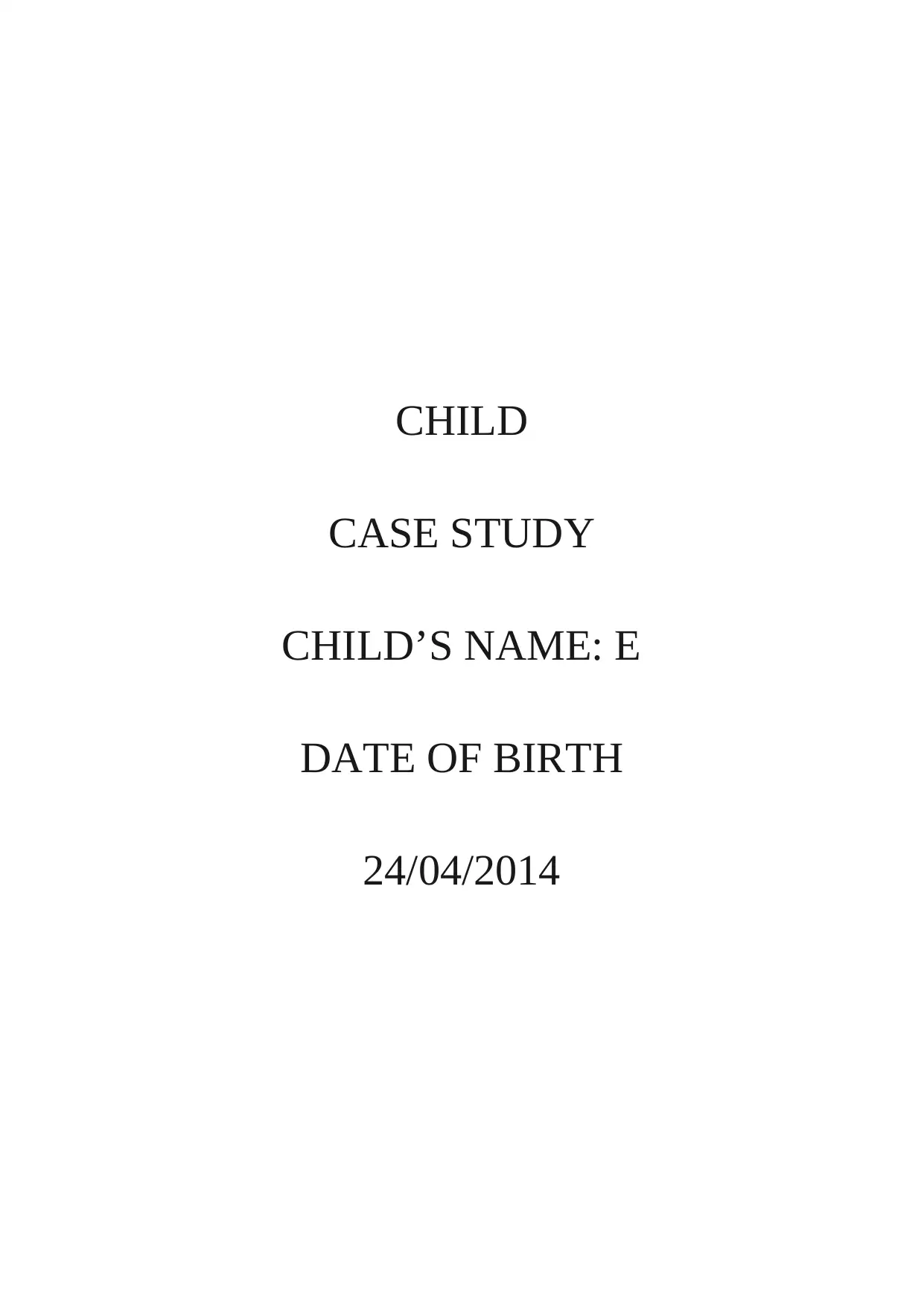
CHILD
CASE STUDY
CHILD’S NAME: E
DATE OF BIRTH
24/04/2014
CASE STUDY
CHILD’S NAME: E
DATE OF BIRTH
24/04/2014
Paraphrase This Document
Need a fresh take? Get an instant paraphrase of this document with our AI Paraphraser
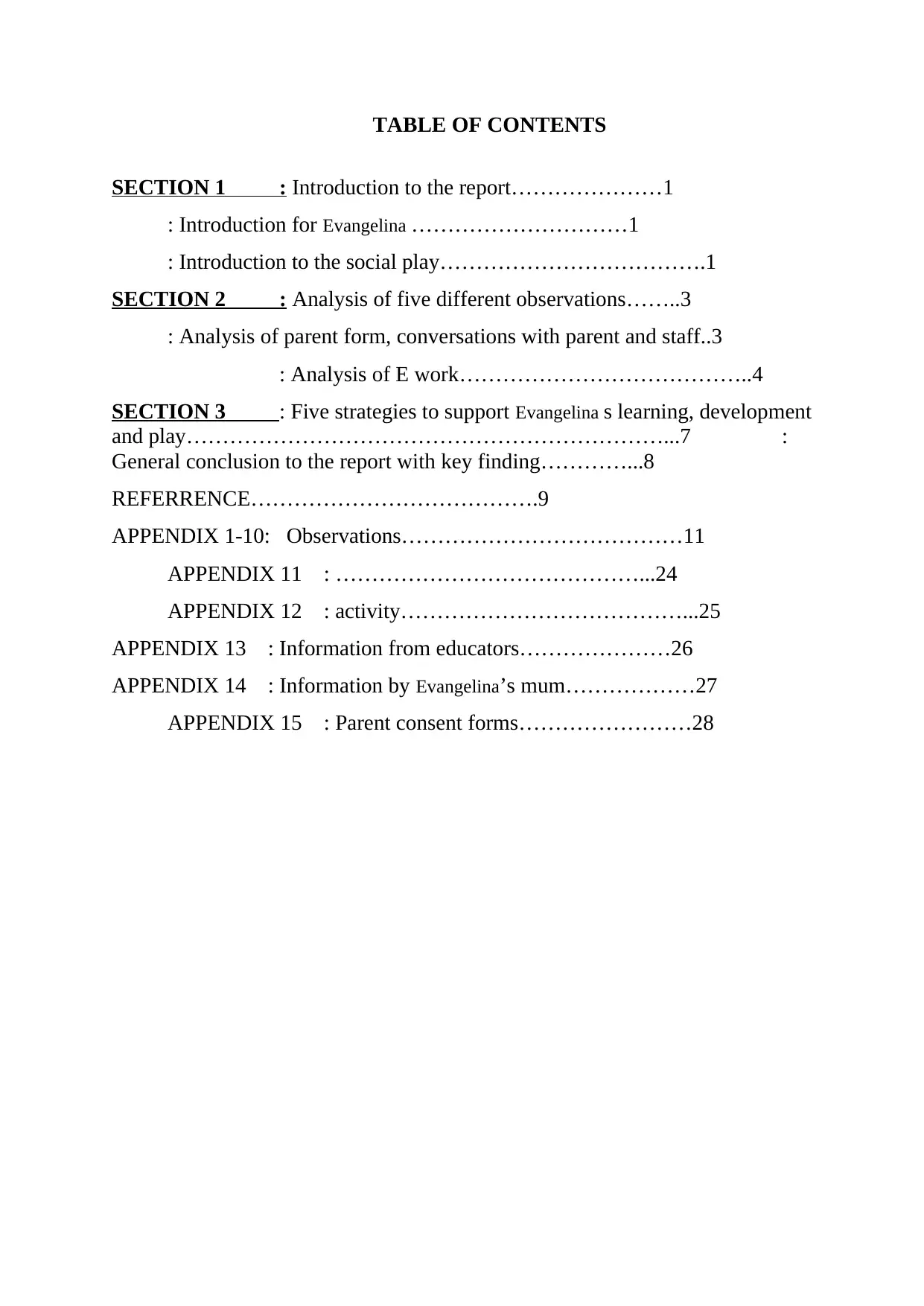
TABLE OF CONTENTS
SECTION 1 : Introduction to the report…………………1
: Introduction for Evangelina …………………………1
: Introduction to the social play……………………………….1
SECTION 2 : Analysis of five different observations……..3
: Analysis of parent form, conversations with parent and staff..3
: Analysis of E work…………………………………..4
SECTION 3 : Five strategies to support Evangelina s learning, development
and play…………………………………………………………...7 :
General conclusion to the report with key finding…………...8
REFERRENCE………………………………….9
APPENDIX 1-10: Observations…………………………………11
APPENDIX 11 : ……………………………………...24
APPENDIX 12 : activity…………………………………...25
APPENDIX 13 : Information from educators…………………26
APPENDIX 14 : Information by Evangelina’s mum………………27
APPENDIX 15 : Parent consent forms……………………28
SECTION 1 : Introduction to the report…………………1
: Introduction for Evangelina …………………………1
: Introduction to the social play……………………………….1
SECTION 2 : Analysis of five different observations……..3
: Analysis of parent form, conversations with parent and staff..3
: Analysis of E work…………………………………..4
SECTION 3 : Five strategies to support Evangelina s learning, development
and play…………………………………………………………...7 :
General conclusion to the report with key finding…………...8
REFERRENCE………………………………….9
APPENDIX 1-10: Observations…………………………………11
APPENDIX 11 : ……………………………………...24
APPENDIX 12 : activity…………………………………...25
APPENDIX 13 : Information from educators…………………26
APPENDIX 14 : Information by Evangelina’s mum………………27
APPENDIX 15 : Parent consent forms……………………28
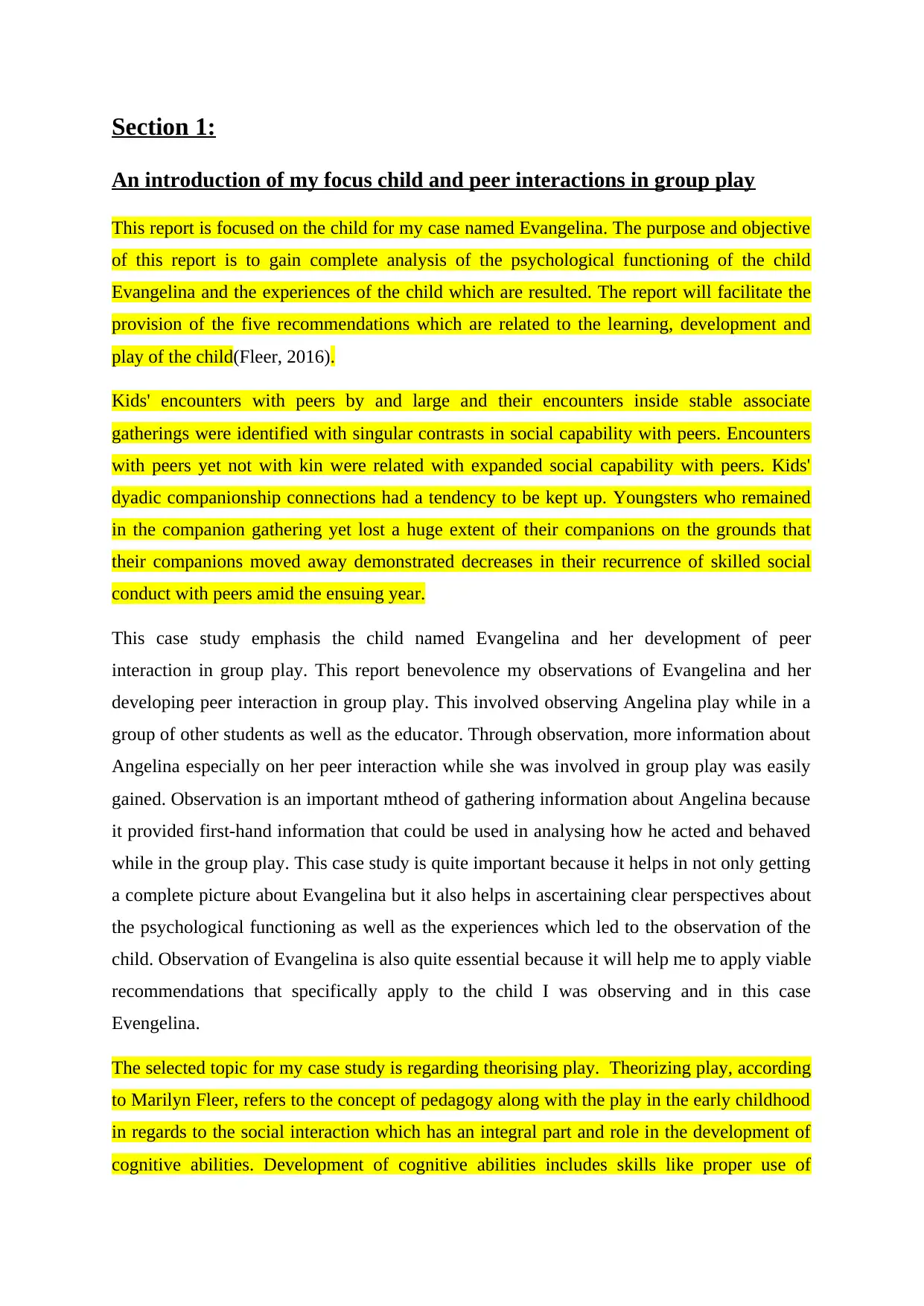
Section 1:
An introduction of my focus child and peer interactions in group play
This report is focused on the child for my case named Evangelina. The purpose and objective
of this report is to gain complete analysis of the psychological functioning of the child
Evangelina and the experiences of the child which are resulted. The report will facilitate the
provision of the five recommendations which are related to the learning, development and
play of the child(Fleer, 2016).
Kids' encounters with peers by and large and their encounters inside stable associate
gatherings were identified with singular contrasts in social capability with peers. Encounters
with peers yet not with kin were related with expanded social capability with peers. Kids'
dyadic companionship connections had a tendency to be kept up. Youngsters who remained
in the companion gathering yet lost a huge extent of their companions on the grounds that
their companions moved away demonstrated decreases in their recurrence of skilled social
conduct with peers amid the ensuing year.
This case study emphasis the child named Evangelina and her development of peer
interaction in group play. This report benevolence my observations of Evangelina and her
developing peer interaction in group play. This involved observing Angelina play while in a
group of other students as well as the educator. Through observation, more information about
Angelina especially on her peer interaction while she was involved in group play was easily
gained. Observation is an important mtheod of gathering information about Angelina because
it provided first-hand information that could be used in analysing how he acted and behaved
while in the group play. This case study is quite important because it helps in not only getting
a complete picture about Evangelina but it also helps in ascertaining clear perspectives about
the psychological functioning as well as the experiences which led to the observation of the
child. Observation of Evangelina is also quite essential because it will help me to apply viable
recommendations that specifically apply to the child I was observing and in this case
Evengelina.
The selected topic for my case study is regarding theorising play. Theorizing play, according
to Marilyn Fleer, refers to the concept of pedagogy along with the play in the early childhood
in regards to the social interaction which has an integral part and role in the development of
cognitive abilities. Development of cognitive abilities includes skills like proper use of
An introduction of my focus child and peer interactions in group play
This report is focused on the child for my case named Evangelina. The purpose and objective
of this report is to gain complete analysis of the psychological functioning of the child
Evangelina and the experiences of the child which are resulted. The report will facilitate the
provision of the five recommendations which are related to the learning, development and
play of the child(Fleer, 2016).
Kids' encounters with peers by and large and their encounters inside stable associate
gatherings were identified with singular contrasts in social capability with peers. Encounters
with peers yet not with kin were related with expanded social capability with peers. Kids'
dyadic companionship connections had a tendency to be kept up. Youngsters who remained
in the companion gathering yet lost a huge extent of their companions on the grounds that
their companions moved away demonstrated decreases in their recurrence of skilled social
conduct with peers amid the ensuing year.
This case study emphasis the child named Evangelina and her development of peer
interaction in group play. This report benevolence my observations of Evangelina and her
developing peer interaction in group play. This involved observing Angelina play while in a
group of other students as well as the educator. Through observation, more information about
Angelina especially on her peer interaction while she was involved in group play was easily
gained. Observation is an important mtheod of gathering information about Angelina because
it provided first-hand information that could be used in analysing how he acted and behaved
while in the group play. This case study is quite important because it helps in not only getting
a complete picture about Evangelina but it also helps in ascertaining clear perspectives about
the psychological functioning as well as the experiences which led to the observation of the
child. Observation of Evangelina is also quite essential because it will help me to apply viable
recommendations that specifically apply to the child I was observing and in this case
Evengelina.
The selected topic for my case study is regarding theorising play. Theorizing play, according
to Marilyn Fleer, refers to the concept of pedagogy along with the play in the early childhood
in regards to the social interaction which has an integral part and role in the development of
cognitive abilities. Development of cognitive abilities includes skills like proper use of
⊘ This is a preview!⊘
Do you want full access?
Subscribe today to unlock all pages.

Trusted by 1+ million students worldwide

language, proper decision making skills, problem solving capacity and skills to have effective
thinking(Kultti& Samuelsson, 2017). The objective of the selected topic in the context of
focus on the child in my case study is that sheis foundto assistEvangelina in developing her
skillsfor social development.
Evangelina is 2 years and 8 months old. She is an Australian born Russian girl. Her mother
came forRussia and father form Greek. She lives with her parents and speaks English very
well. She is very confident and solitary play child. She has two step brothers but she meets
with him sometime. She is only one child at home and doesn’t have much social interaction
with her cousins and siblings. Her mother is concerns about her behaviour, social
development skills.Evangelina is the only child to stay at her home which cuts off any kind of
opportunity to be with any of her siblings or cousins. This further restricts her interaction on
the social front which could lead to the psychological development. It was further observed
that her mother is also very much concerned regarding her psychological condition.The
objective of the report is also focussed around having effective conversationswith the
educators of the child in my case study anddevise ways in which the cognitive behaviour of
thechild can be improved(Lilja&Baaz, 2016). As Evangelina is foundto prefer to stay in
isolation and not engage in having social interactionsand make friends, it is very much clear
thatshe will not be undergoing any development in any of her career and social life in future
of the condition is not correctedor given attention to at this tender age where it is in theinitial
stage and corrective phase.
Analysis of data and discussion:
In the Toddler room of my working experience with different children and different
educators, I have gained lots of knowledge and experience on how best to handle children
and ensure that positive aspects are achieved out of their play with others and even when they
are alone. I discussed about Evangelina with her different educators, how we can improve her
thinking(Kultti& Samuelsson, 2017). The objective of the selected topic in the context of
focus on the child in my case study is that sheis foundto assistEvangelina in developing her
skillsfor social development.
Evangelina is 2 years and 8 months old. She is an Australian born Russian girl. Her mother
came forRussia and father form Greek. She lives with her parents and speaks English very
well. She is very confident and solitary play child. She has two step brothers but she meets
with him sometime. She is only one child at home and doesn’t have much social interaction
with her cousins and siblings. Her mother is concerns about her behaviour, social
development skills.Evangelina is the only child to stay at her home which cuts off any kind of
opportunity to be with any of her siblings or cousins. This further restricts her interaction on
the social front which could lead to the psychological development. It was further observed
that her mother is also very much concerned regarding her psychological condition.The
objective of the report is also focussed around having effective conversationswith the
educators of the child in my case study anddevise ways in which the cognitive behaviour of
thechild can be improved(Lilja&Baaz, 2016). As Evangelina is foundto prefer to stay in
isolation and not engage in having social interactionsand make friends, it is very much clear
thatshe will not be undergoing any development in any of her career and social life in future
of the condition is not correctedor given attention to at this tender age where it is in theinitial
stage and corrective phase.
Analysis of data and discussion:
In the Toddler room of my working experience with different children and different
educators, I have gained lots of knowledge and experience on how best to handle children
and ensure that positive aspects are achieved out of their play with others and even when they
are alone. I discussed about Evangelina with her different educators, how we can improve her
Paraphrase This Document
Need a fresh take? Get an instant paraphrase of this document with our AI Paraphraser
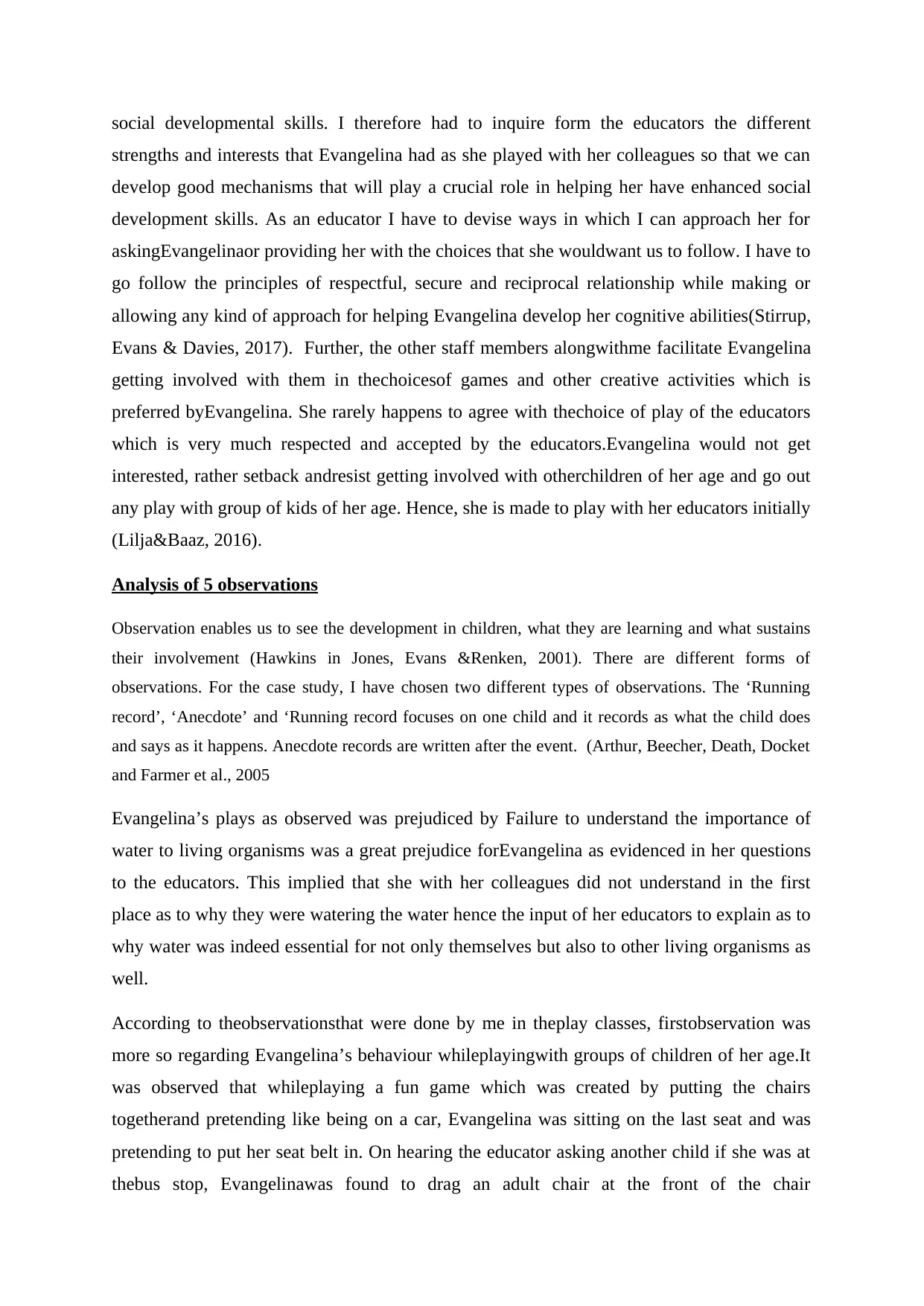
social developmental skills. I therefore had to inquire form the educators the different
strengths and interests that Evangelina had as she played with her colleagues so that we can
develop good mechanisms that will play a crucial role in helping her have enhanced social
development skills. As an educator I have to devise ways in which I can approach her for
askingEvangelinaor providing her with the choices that she wouldwant us to follow. I have to
go follow the principles of respectful, secure and reciprocal relationship while making or
allowing any kind of approach for helping Evangelina develop her cognitive abilities(Stirrup,
Evans & Davies, 2017). Further, the other staff members alongwithme facilitate Evangelina
getting involved with them in thechoicesof games and other creative activities which is
preferred byEvangelina. She rarely happens to agree with thechoice of play of the educators
which is very much respected and accepted by the educators.Evangelina would not get
interested, rather setback andresist getting involved with otherchildren of her age and go out
any play with group of kids of her age. Hence, she is made to play with her educators initially
(Lilja&Baaz, 2016).
Analysis of 5 observations
Observation enables us to see the development in children, what they are learning and what sustains
their involvement (Hawkins in Jones, Evans &Renken, 2001). There are different forms of
observations. For the case study, I have chosen two different types of observations. The ‘Running
record’, ‘Anecdote’ and ‘Running record focuses on one child and it records as what the child does
and says as it happens. Anecdote records are written after the event. (Arthur, Beecher, Death, Docket
and Farmer et al., 2005
Evangelina’s plays as observed was prejudiced by Failure to understand the importance of
water to living organisms was a great prejudice forEvangelina as evidenced in her questions
to the educators. This implied that she with her colleagues did not understand in the first
place as to why they were watering the water hence the input of her educators to explain as to
why water was indeed essential for not only themselves but also to other living organisms as
well.
According to theobservationsthat were done by me in theplay classes, firstobservation was
more so regarding Evangelina’s behaviour whileplayingwith groups of children of her age.It
was observed that whileplaying a fun game which was created by putting the chairs
togetherand pretending like being on a car, Evangelina was sitting on the last seat and was
pretending to put her seat belt in. On hearing the educator asking another child if she was at
thebus stop, Evangelinawas found to drag an adult chair at the front of the chair
strengths and interests that Evangelina had as she played with her colleagues so that we can
develop good mechanisms that will play a crucial role in helping her have enhanced social
development skills. As an educator I have to devise ways in which I can approach her for
askingEvangelinaor providing her with the choices that she wouldwant us to follow. I have to
go follow the principles of respectful, secure and reciprocal relationship while making or
allowing any kind of approach for helping Evangelina develop her cognitive abilities(Stirrup,
Evans & Davies, 2017). Further, the other staff members alongwithme facilitate Evangelina
getting involved with them in thechoicesof games and other creative activities which is
preferred byEvangelina. She rarely happens to agree with thechoice of play of the educators
which is very much respected and accepted by the educators.Evangelina would not get
interested, rather setback andresist getting involved with otherchildren of her age and go out
any play with group of kids of her age. Hence, she is made to play with her educators initially
(Lilja&Baaz, 2016).
Analysis of 5 observations
Observation enables us to see the development in children, what they are learning and what sustains
their involvement (Hawkins in Jones, Evans &Renken, 2001). There are different forms of
observations. For the case study, I have chosen two different types of observations. The ‘Running
record’, ‘Anecdote’ and ‘Running record focuses on one child and it records as what the child does
and says as it happens. Anecdote records are written after the event. (Arthur, Beecher, Death, Docket
and Farmer et al., 2005
Evangelina’s plays as observed was prejudiced by Failure to understand the importance of
water to living organisms was a great prejudice forEvangelina as evidenced in her questions
to the educators. This implied that she with her colleagues did not understand in the first
place as to why they were watering the water hence the input of her educators to explain as to
why water was indeed essential for not only themselves but also to other living organisms as
well.
According to theobservationsthat were done by me in theplay classes, firstobservation was
more so regarding Evangelina’s behaviour whileplayingwith groups of children of her age.It
was observed that whileplaying a fun game which was created by putting the chairs
togetherand pretending like being on a car, Evangelina was sitting on the last seat and was
pretending to put her seat belt in. On hearing the educator asking another child if she was at
thebus stop, Evangelinawas found to drag an adult chair at the front of the chair

arrangementsand pretended to be driving thebus. Shewas also found to be actively
participating in thegame and acting as if she was steeringthe wheel. This showed thatshe was
actively participating in playing games and even hastheinterest in leading the play group. She
was also observed to useher previous knowledge and apply them in all thedramatic play
which reflectedher very good memory recall. She was found tobe involved in group activity
and be cooperative in the games with other children. She was found to enjoythe games as she
was singing all along the game.
Secondly, it was observed thatshe was using her creativity and imagination while playing
outdoors in the sand. She used her creativity in making sand structures andwas getting
involved inthe game actively with thechildren of her age playing with her. From thethird
observation, it was even noticed thatshe enjoys eating. She shared the food table with the
children of her ageand had developedthe fondness in sharing food. She was also found tobe
playing indoor games actively with thechildren of her age. In the fourth observation, it was
found that she has become very much comfortable in playing inthe company of tother
children. She was found to be actively participating in various games. According to the fourth
observation, Evangelina enthusiastically joined theactivity of planting plants and watering
theses could very well mention the materialsthatare actually requiredforplantation. She was
very eager to know why the plants need water for survival.
According to the theory of learning of Vygotsky, having social interaction is very much
required for the development, cognition and consciousness amongthechildren whichwould
enhance thesocial behaviour and socialization of thechildren. This is very relevant to the case
of Evangelina as she is ableto develop her cognitive ability with more participation and
involvement in the children group of play.
Having curiosity regarding any matter in childhood is a very naturalthing which refers to the
scope and possibilities of providingvariousapproaches to develop the cognitive understanding
regardingthe matter of watering the living creatureslike plants by Evangelina and her friend.
It was observed that Evangelinawould need to be approached through the modes of creative
imagination, whichcould be demonstrated by one example inwhichthe educatorsincluding me
would take a sample of plant and show the experiment. The experiment would show that not
watering the plants wouldresult them to die. In accordance to thetheory Vygotsky, social and
cognitive developments are improvedthrough the approaches of friendshipwhich isbasically
not preferred by Evangelina.
participating in thegame and acting as if she was steeringthe wheel. This showed thatshe was
actively participating in playing games and even hastheinterest in leading the play group. She
was also observed to useher previous knowledge and apply them in all thedramatic play
which reflectedher very good memory recall. She was found tobe involved in group activity
and be cooperative in the games with other children. She was found to enjoythe games as she
was singing all along the game.
Secondly, it was observed thatshe was using her creativity and imagination while playing
outdoors in the sand. She used her creativity in making sand structures andwas getting
involved inthe game actively with thechildren of her age playing with her. From thethird
observation, it was even noticed thatshe enjoys eating. She shared the food table with the
children of her ageand had developedthe fondness in sharing food. She was also found tobe
playing indoor games actively with thechildren of her age. In the fourth observation, it was
found that she has become very much comfortable in playing inthe company of tother
children. She was found to be actively participating in various games. According to the fourth
observation, Evangelina enthusiastically joined theactivity of planting plants and watering
theses could very well mention the materialsthatare actually requiredforplantation. She was
very eager to know why the plants need water for survival.
According to the theory of learning of Vygotsky, having social interaction is very much
required for the development, cognition and consciousness amongthechildren whichwould
enhance thesocial behaviour and socialization of thechildren. This is very relevant to the case
of Evangelina as she is ableto develop her cognitive ability with more participation and
involvement in the children group of play.
Having curiosity regarding any matter in childhood is a very naturalthing which refers to the
scope and possibilities of providingvariousapproaches to develop the cognitive understanding
regardingthe matter of watering the living creatureslike plants by Evangelina and her friend.
It was observed that Evangelinawould need to be approached through the modes of creative
imagination, whichcould be demonstrated by one example inwhichthe educatorsincluding me
would take a sample of plant and show the experiment. The experiment would show that not
watering the plants wouldresult them to die. In accordance to thetheory Vygotsky, social and
cognitive developments are improvedthrough the approaches of friendshipwhich isbasically
not preferred by Evangelina.
⊘ This is a preview!⊘
Do you want full access?
Subscribe today to unlock all pages.

Trusted by 1+ million students worldwide
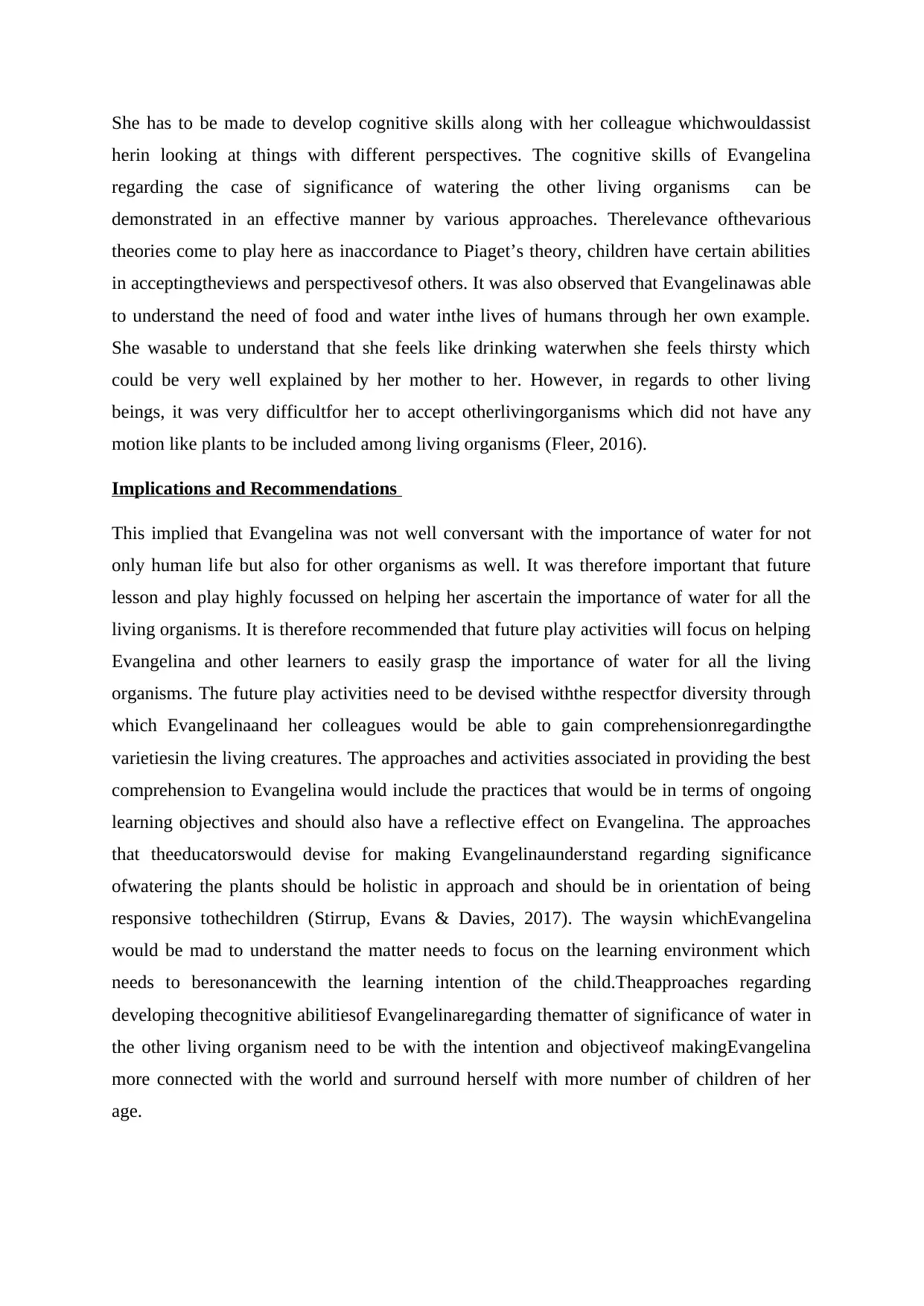
She has to be made to develop cognitive skills along with her colleague whichwouldassist
herin looking at things with different perspectives. The cognitive skills of Evangelina
regarding the case of significance of watering the other living organisms can be
demonstrated in an effective manner by various approaches. Therelevance ofthevarious
theories come to play here as inaccordance to Piaget’s theory, children have certain abilities
in acceptingtheviews and perspectivesof others. It was also observed that Evangelinawas able
to understand the need of food and water inthe lives of humans through her own example.
She wasable to understand that she feels like drinking waterwhen she feels thirsty which
could be very well explained by her mother to her. However, in regards to other living
beings, it was very difficultfor her to accept otherlivingorganisms which did not have any
motion like plants to be included among living organisms (Fleer, 2016).
Implications and Recommendations
This implied that Evangelina was not well conversant with the importance of water for not
only human life but also for other organisms as well. It was therefore important that future
lesson and play highly focussed on helping her ascertain the importance of water for all the
living organisms. It is therefore recommended that future play activities will focus on helping
Evangelina and other learners to easily grasp the importance of water for all the living
organisms. The future play activities need to be devised withthe respectfor diversity through
which Evangelinaand her colleagues would be able to gain comprehensionregardingthe
varietiesin the living creatures. The approaches and activities associated in providing the best
comprehension to Evangelina would include the practices that would be in terms of ongoing
learning objectives and should also have a reflective effect on Evangelina. The approaches
that theeducatorswould devise for making Evangelinaunderstand regarding significance
ofwatering the plants should be holistic in approach and should be in orientation of being
responsive tothechildren (Stirrup, Evans & Davies, 2017). The waysin whichEvangelina
would be mad to understand the matter needs to focus on the learning environment which
needs to beresonancewith the learning intention of the child.Theapproaches regarding
developing thecognitive abilitiesof Evangelinaregarding thematter of significance of water in
the other living organism need to be with the intention and objectiveof makingEvangelina
more connected with the world and surround herself with more number of children of her
age.
herin looking at things with different perspectives. The cognitive skills of Evangelina
regarding the case of significance of watering the other living organisms can be
demonstrated in an effective manner by various approaches. Therelevance ofthevarious
theories come to play here as inaccordance to Piaget’s theory, children have certain abilities
in acceptingtheviews and perspectivesof others. It was also observed that Evangelinawas able
to understand the need of food and water inthe lives of humans through her own example.
She wasable to understand that she feels like drinking waterwhen she feels thirsty which
could be very well explained by her mother to her. However, in regards to other living
beings, it was very difficultfor her to accept otherlivingorganisms which did not have any
motion like plants to be included among living organisms (Fleer, 2016).
Implications and Recommendations
This implied that Evangelina was not well conversant with the importance of water for not
only human life but also for other organisms as well. It was therefore important that future
lesson and play highly focussed on helping her ascertain the importance of water for all the
living organisms. It is therefore recommended that future play activities will focus on helping
Evangelina and other learners to easily grasp the importance of water for all the living
organisms. The future play activities need to be devised withthe respectfor diversity through
which Evangelinaand her colleagues would be able to gain comprehensionregardingthe
varietiesin the living creatures. The approaches and activities associated in providing the best
comprehension to Evangelina would include the practices that would be in terms of ongoing
learning objectives and should also have a reflective effect on Evangelina. The approaches
that theeducatorswould devise for making Evangelinaunderstand regarding significance
ofwatering the plants should be holistic in approach and should be in orientation of being
responsive tothechildren (Stirrup, Evans & Davies, 2017). The waysin whichEvangelina
would be mad to understand the matter needs to focus on the learning environment which
needs to beresonancewith the learning intention of the child.Theapproaches regarding
developing thecognitive abilitiesof Evangelinaregarding thematter of significance of water in
the other living organism need to be with the intention and objectiveof makingEvangelina
more connected with the world and surround herself with more number of children of her
age.
Paraphrase This Document
Need a fresh take? Get an instant paraphrase of this document with our AI Paraphraser
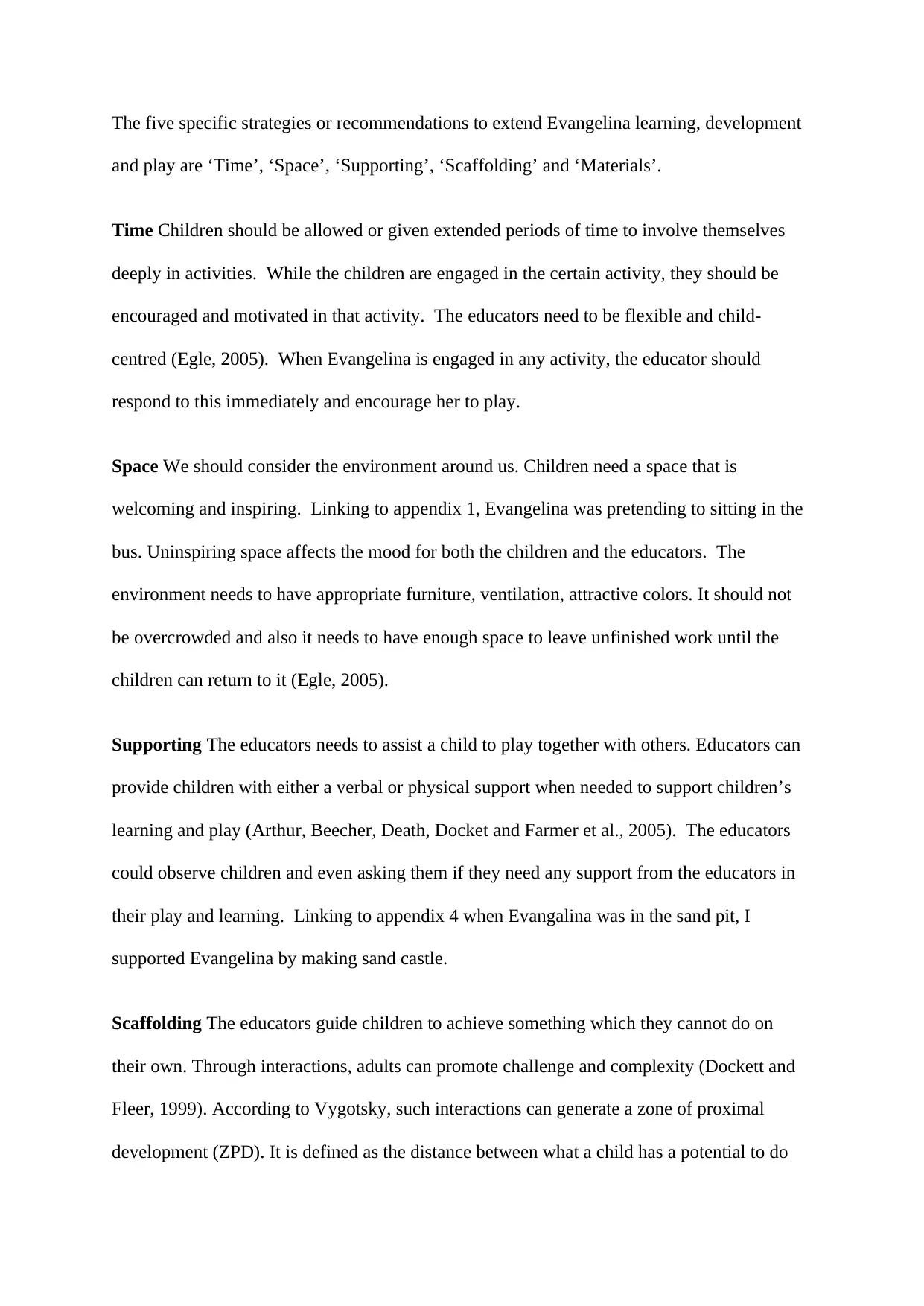
The five specific strategies or recommendations to extend Evangelina learning, development
and play are ‘Time’, ‘Space’, ‘Supporting’, ‘Scaffolding’ and ‘Materials’.
Time Children should be allowed or given extended periods of time to involve themselves
deeply in activities. While the children are engaged in the certain activity, they should be
encouraged and motivated in that activity. The educators need to be flexible and child-
centred (Egle, 2005). When Evangelina is engaged in any activity, the educator should
respond to this immediately and encourage her to play.
Space We should consider the environment around us. Children need a space that is
welcoming and inspiring. Linking to appendix 1, Evangelina was pretending to sitting in the
bus. Uninspiring space affects the mood for both the children and the educators. The
environment needs to have appropriate furniture, ventilation, attractive colors. It should not
be overcrowded and also it needs to have enough space to leave unfinished work until the
children can return to it (Egle, 2005).
Supporting The educators needs to assist a child to play together with others. Educators can
provide children with either a verbal or physical support when needed to support children’s
learning and play (Arthur, Beecher, Death, Docket and Farmer et al., 2005). The educators
could observe children and even asking them if they need any support from the educators in
their play and learning. Linking to appendix 4 when Evangalina was in the sand pit, I
supported Evangelina by making sand castle.
Scaffolding The educators guide children to achieve something which they cannot do on
their own. Through interactions, adults can promote challenge and complexity (Dockett and
Fleer, 1999). According to Vygotsky, such interactions can generate a zone of proximal
development (ZPD). It is defined as the distance between what a child has a potential to do
and play are ‘Time’, ‘Space’, ‘Supporting’, ‘Scaffolding’ and ‘Materials’.
Time Children should be allowed or given extended periods of time to involve themselves
deeply in activities. While the children are engaged in the certain activity, they should be
encouraged and motivated in that activity. The educators need to be flexible and child-
centred (Egle, 2005). When Evangelina is engaged in any activity, the educator should
respond to this immediately and encourage her to play.
Space We should consider the environment around us. Children need a space that is
welcoming and inspiring. Linking to appendix 1, Evangelina was pretending to sitting in the
bus. Uninspiring space affects the mood for both the children and the educators. The
environment needs to have appropriate furniture, ventilation, attractive colors. It should not
be overcrowded and also it needs to have enough space to leave unfinished work until the
children can return to it (Egle, 2005).
Supporting The educators needs to assist a child to play together with others. Educators can
provide children with either a verbal or physical support when needed to support children’s
learning and play (Arthur, Beecher, Death, Docket and Farmer et al., 2005). The educators
could observe children and even asking them if they need any support from the educators in
their play and learning. Linking to appendix 4 when Evangalina was in the sand pit, I
supported Evangelina by making sand castle.
Scaffolding The educators guide children to achieve something which they cannot do on
their own. Through interactions, adults can promote challenge and complexity (Dockett and
Fleer, 1999). According to Vygotsky, such interactions can generate a zone of proximal
development (ZPD). It is defined as the distance between what a child has a potential to do
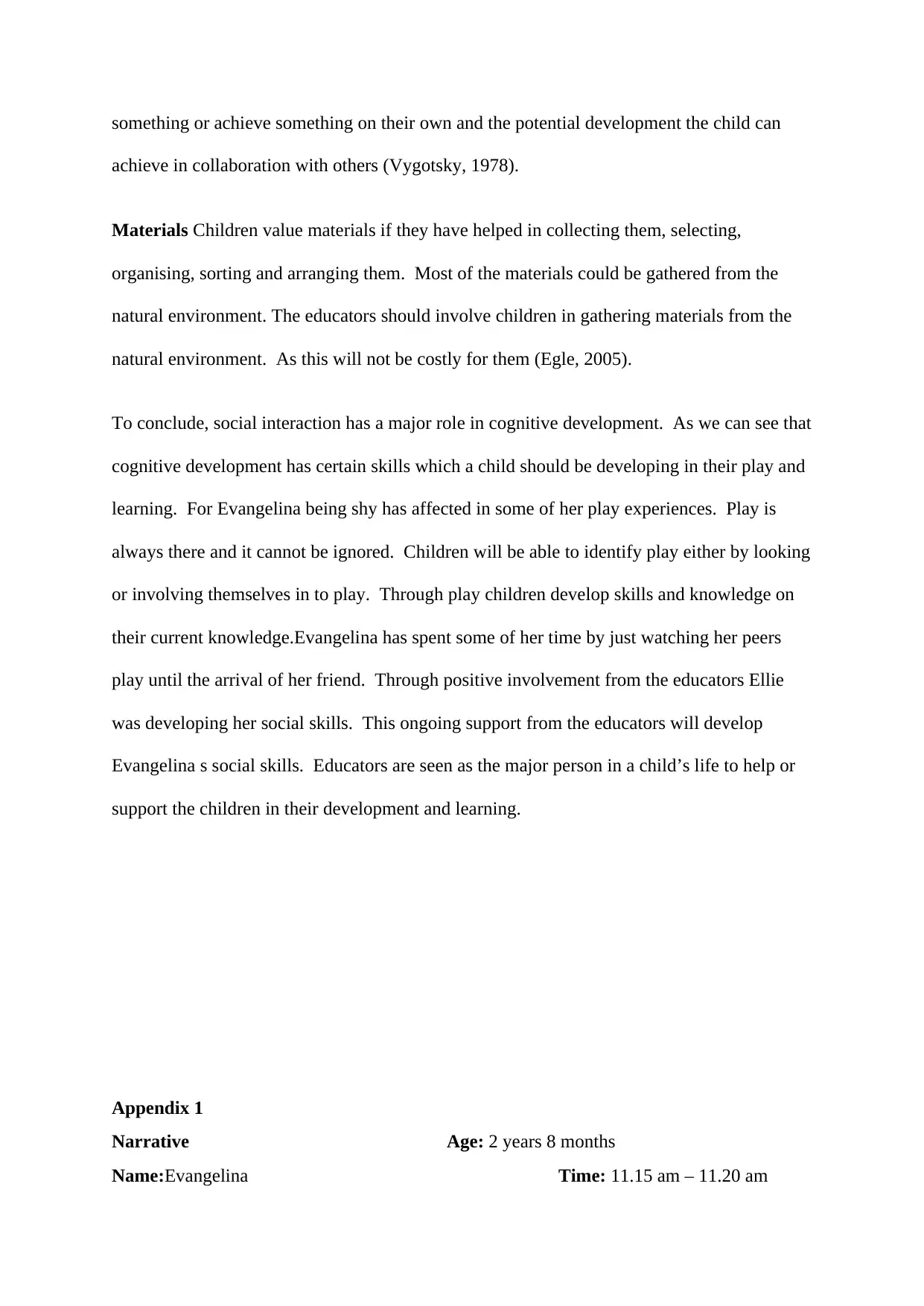
something or achieve something on their own and the potential development the child can
achieve in collaboration with others (Vygotsky, 1978).
Materials Children value materials if they have helped in collecting them, selecting,
organising, sorting and arranging them. Most of the materials could be gathered from the
natural environment. The educators should involve children in gathering materials from the
natural environment. As this will not be costly for them (Egle, 2005).
To conclude, social interaction has a major role in cognitive development. As we can see that
cognitive development has certain skills which a child should be developing in their play and
learning. For Evangelina being shy has affected in some of her play experiences. Play is
always there and it cannot be ignored. Children will be able to identify play either by looking
or involving themselves in to play. Through play children develop skills and knowledge on
their current knowledge.Evangelina has spent some of her time by just watching her peers
play until the arrival of her friend. Through positive involvement from the educators Ellie
was developing her social skills. This ongoing support from the educators will develop
Evangelina s social skills. Educators are seen as the major person in a child’s life to help or
support the children in their development and learning.
Appendix 1
Narrative Age: 2 years 8 months
Name:Evangelina Time: 11.15 am – 11.20 am
achieve in collaboration with others (Vygotsky, 1978).
Materials Children value materials if they have helped in collecting them, selecting,
organising, sorting and arranging them. Most of the materials could be gathered from the
natural environment. The educators should involve children in gathering materials from the
natural environment. As this will not be costly for them (Egle, 2005).
To conclude, social interaction has a major role in cognitive development. As we can see that
cognitive development has certain skills which a child should be developing in their play and
learning. For Evangelina being shy has affected in some of her play experiences. Play is
always there and it cannot be ignored. Children will be able to identify play either by looking
or involving themselves in to play. Through play children develop skills and knowledge on
their current knowledge.Evangelina has spent some of her time by just watching her peers
play until the arrival of her friend. Through positive involvement from the educators Ellie
was developing her social skills. This ongoing support from the educators will develop
Evangelina s social skills. Educators are seen as the major person in a child’s life to help or
support the children in their development and learning.
Appendix 1
Narrative Age: 2 years 8 months
Name:Evangelina Time: 11.15 am – 11.20 am
⊘ This is a preview!⊘
Do you want full access?
Subscribe today to unlock all pages.

Trusted by 1+ million students worldwide
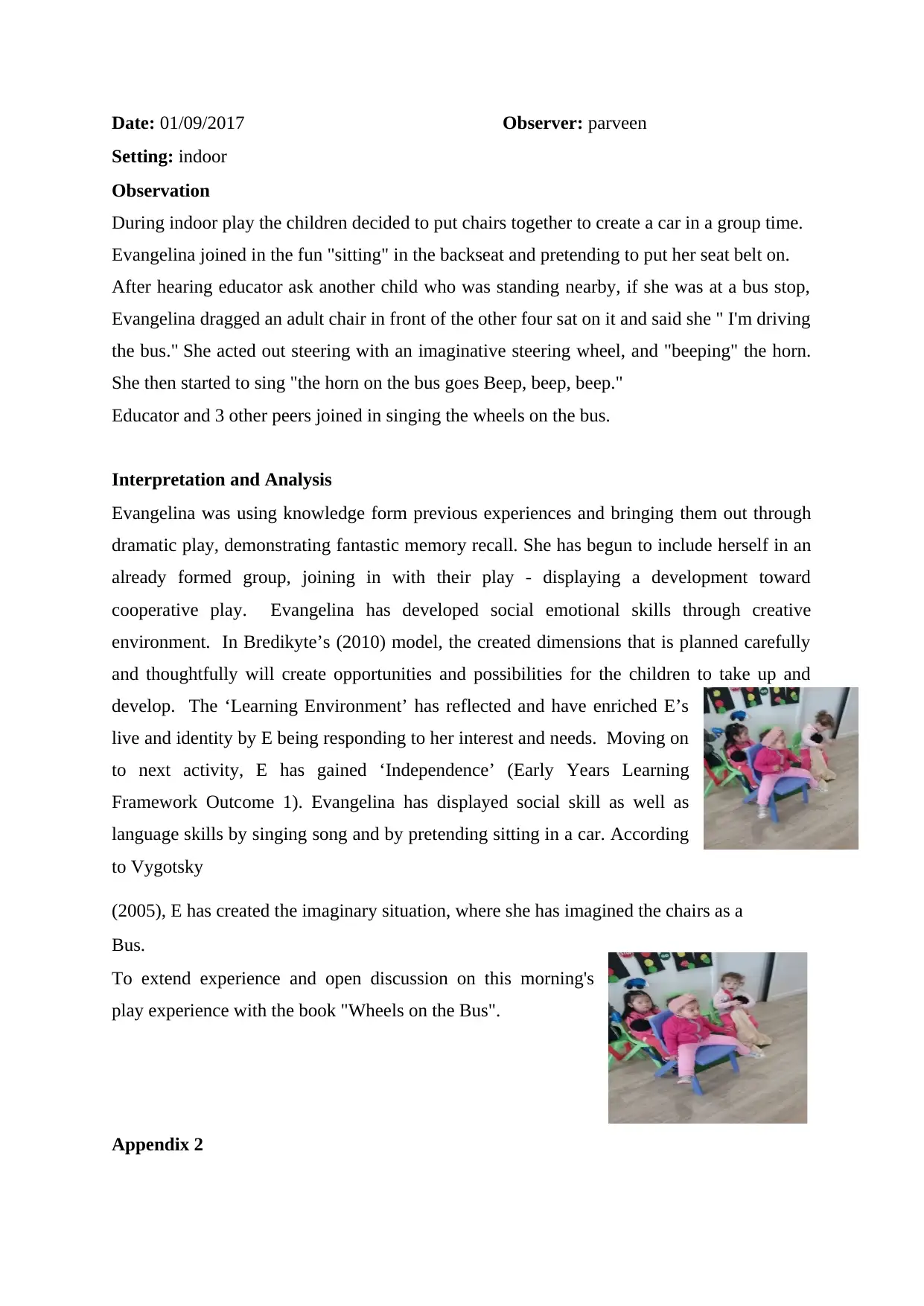
Date: 01/09/2017 Observer: parveen
Setting: indoor
Observation
During indoor play the children decided to put chairs together to create a car in a group time.
Evangelina joined in the fun "sitting" in the backseat and pretending to put her seat belt on.
After hearing educator ask another child who was standing nearby, if she was at a bus stop,
Evangelina dragged an adult chair in front of the other four sat on it and said she " I'm driving
the bus." She acted out steering with an imaginative steering wheel, and "beeping" the horn.
She then started to sing "the horn on the bus goes Beep, beep, beep."
Educator and 3 other peers joined in singing the wheels on the bus.
Interpretation and Analysis
Evangelina was using knowledge form previous experiences and bringing them out through
dramatic play, demonstrating fantastic memory recall. She has begun to include herself in an
already formed group, joining in with their play - displaying a development toward
cooperative play. Evangelina has developed social emotional skills through creative
environment. In Bredikyte’s (2010) model, the created dimensions that is planned carefully
and thoughtfully will create opportunities and possibilities for the children to take up and
develop. The ‘Learning Environment’ has reflected and have enriched E’s
live and identity by E being responding to her interest and needs. Moving on
to next activity, E has gained ‘Independence’ (Early Years Learning
Framework Outcome 1). Evangelina has displayed social skill as well as
language skills by singing song and by pretending sitting in a car. According
to Vygotsky
(2005), E has created the imaginary situation, where she has imagined the chairs as a
Bus.
To extend experience and open discussion on this morning's
play experience with the book "Wheels on the Bus".
Appendix 2
Setting: indoor
Observation
During indoor play the children decided to put chairs together to create a car in a group time.
Evangelina joined in the fun "sitting" in the backseat and pretending to put her seat belt on.
After hearing educator ask another child who was standing nearby, if she was at a bus stop,
Evangelina dragged an adult chair in front of the other four sat on it and said she " I'm driving
the bus." She acted out steering with an imaginative steering wheel, and "beeping" the horn.
She then started to sing "the horn on the bus goes Beep, beep, beep."
Educator and 3 other peers joined in singing the wheels on the bus.
Interpretation and Analysis
Evangelina was using knowledge form previous experiences and bringing them out through
dramatic play, demonstrating fantastic memory recall. She has begun to include herself in an
already formed group, joining in with their play - displaying a development toward
cooperative play. Evangelina has developed social emotional skills through creative
environment. In Bredikyte’s (2010) model, the created dimensions that is planned carefully
and thoughtfully will create opportunities and possibilities for the children to take up and
develop. The ‘Learning Environment’ has reflected and have enriched E’s
live and identity by E being responding to her interest and needs. Moving on
to next activity, E has gained ‘Independence’ (Early Years Learning
Framework Outcome 1). Evangelina has displayed social skill as well as
language skills by singing song and by pretending sitting in a car. According
to Vygotsky
(2005), E has created the imaginary situation, where she has imagined the chairs as a
Bus.
To extend experience and open discussion on this morning's
play experience with the book "Wheels on the Bus".
Appendix 2
Paraphrase This Document
Need a fresh take? Get an instant paraphrase of this document with our AI Paraphraser

Anecdote
Child: Evangelina Age: 2 years 8 months
Date: 05/09/17 Observer: Parveen
Context
Observation took place in dramatic area. Material available were mat, dolls, dolls clothes,
blankets and rocking chairs that E participated in. Other children present were N and F.
Observation
E was sitting on the mat with dolls clothes in front of her. N said, ‘E let’s put the clothes
for the baby’. E said, let’s put the clothes for the baby’. F said, ‘look at this N, we
have blankets’. F gives the blankets to E and N. E looks at F and N
wrapping the doll with the blanket. E starts to wrap the doll with the blanket. N said,
‘E, I am going to sit on the chair to make the baby sleep and you
can come too’. E then
stands up and sits next to N. N said, ‘E I like the chair and it is
moving’. E said,
‘I like the chair and it is moving’. E has the doll on her lap and
rocks on the chair.
Interpretation and Analysis
E seems to be interested in dramatic play with her peers. E with
her friend N sat on the
rocking chair with the dolls. According to Vygotsky, social
development is developed through ‘Friendship’. E
has developed social skills by playing with her
friends only. Vygotsky has
stated the stages of play. Here the children are in the stage of
‘Co-operative play’. Children
have grouped themselves and get on well with each other and
talks among themselves.
According to Piaget’s theory, four year old children have some ability to accept the
perspective
of another person. E has listened to her peer N to put clothes on for the doll and also
sitting on the rocking chair with the doll. E with her peers have developed a strong sense of
belonging by interacting among her peers (Early Years Learning Framework Outcome).
What can I do to extend the child’s /children’s learning or development and play?
To further develop E’s social skills I would plan dramatic play of dolls and doctor’s sets with
her peers.
Child: Evangelina Age: 2 years 8 months
Date: 05/09/17 Observer: Parveen
Context
Observation took place in dramatic area. Material available were mat, dolls, dolls clothes,
blankets and rocking chairs that E participated in. Other children present were N and F.
Observation
E was sitting on the mat with dolls clothes in front of her. N said, ‘E let’s put the clothes
for the baby’. E said, let’s put the clothes for the baby’. F said, ‘look at this N, we
have blankets’. F gives the blankets to E and N. E looks at F and N
wrapping the doll with the blanket. E starts to wrap the doll with the blanket. N said,
‘E, I am going to sit on the chair to make the baby sleep and you
can come too’. E then
stands up and sits next to N. N said, ‘E I like the chair and it is
moving’. E said,
‘I like the chair and it is moving’. E has the doll on her lap and
rocks on the chair.
Interpretation and Analysis
E seems to be interested in dramatic play with her peers. E with
her friend N sat on the
rocking chair with the dolls. According to Vygotsky, social
development is developed through ‘Friendship’. E
has developed social skills by playing with her
friends only. Vygotsky has
stated the stages of play. Here the children are in the stage of
‘Co-operative play’. Children
have grouped themselves and get on well with each other and
talks among themselves.
According to Piaget’s theory, four year old children have some ability to accept the
perspective
of another person. E has listened to her peer N to put clothes on for the doll and also
sitting on the rocking chair with the doll. E with her peers have developed a strong sense of
belonging by interacting among her peers (Early Years Learning Framework Outcome).
What can I do to extend the child’s /children’s learning or development and play?
To further develop E’s social skills I would plan dramatic play of dolls and doctor’s sets with
her peers.
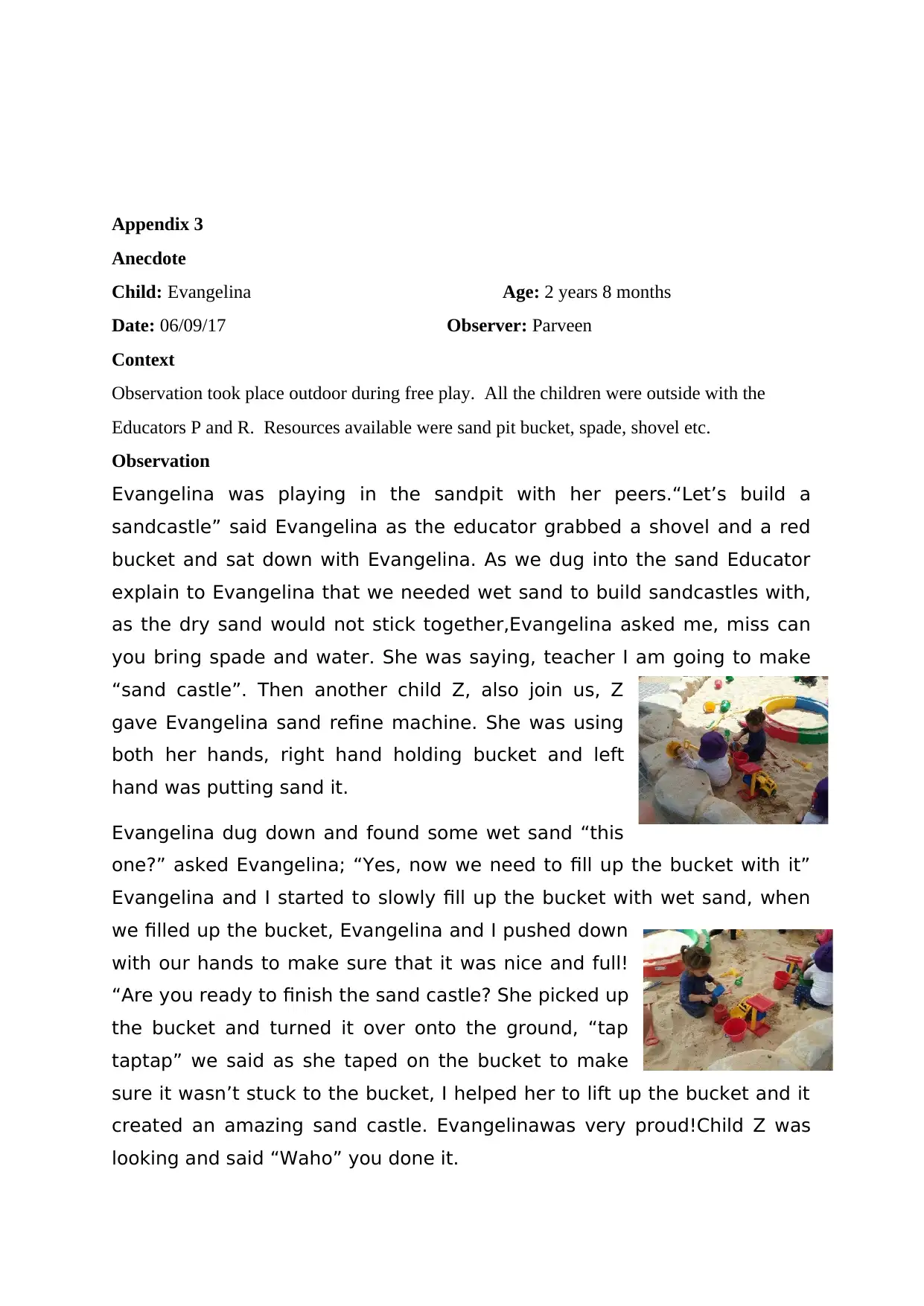
Appendix 3
Anecdote
Child: Evangelina Age: 2 years 8 months
Date: 06/09/17 Observer: Parveen
Context
Observation took place outdoor during free play. All the children were outside with the
Educators P and R. Resources available were sand pit bucket, spade, shovel etc.
Observation
Evangelina was playing in the sandpit with her peers.“Let’s build a
sandcastle” said Evangelina as the educator grabbed a shovel and a red
bucket and sat down with Evangelina. As we dug into the sand Educator
explain to Evangelina that we needed wet sand to build sandcastles with,
as the dry sand would not stick together,Evangelina asked me, miss can
you bring spade and water. She was saying, teacher I am going to make
“sand castle”. Then another child Z, also join us, Z
gave Evangelina sand refine machine. She was using
both her hands, right hand holding bucket and left
hand was putting sand it.
Evangelina dug down and found some wet sand “this
one?” asked Evangelina; “Yes, now we need to fill up the bucket with it”
Evangelina and I started to slowly fill up the bucket with wet sand, when
we filled up the bucket, Evangelina and I pushed down
with our hands to make sure that it was nice and full!
“Are you ready to finish the sand castle? She picked up
the bucket and turned it over onto the ground, “tap
taptap” we said as she taped on the bucket to make
sure it wasn’t stuck to the bucket, I helped her to lift up the bucket and it
created an amazing sand castle. Evangelinawas very proud!Child Z was
looking and said “Waho” you done it.
Anecdote
Child: Evangelina Age: 2 years 8 months
Date: 06/09/17 Observer: Parveen
Context
Observation took place outdoor during free play. All the children were outside with the
Educators P and R. Resources available were sand pit bucket, spade, shovel etc.
Observation
Evangelina was playing in the sandpit with her peers.“Let’s build a
sandcastle” said Evangelina as the educator grabbed a shovel and a red
bucket and sat down with Evangelina. As we dug into the sand Educator
explain to Evangelina that we needed wet sand to build sandcastles with,
as the dry sand would not stick together,Evangelina asked me, miss can
you bring spade and water. She was saying, teacher I am going to make
“sand castle”. Then another child Z, also join us, Z
gave Evangelina sand refine machine. She was using
both her hands, right hand holding bucket and left
hand was putting sand it.
Evangelina dug down and found some wet sand “this
one?” asked Evangelina; “Yes, now we need to fill up the bucket with it”
Evangelina and I started to slowly fill up the bucket with wet sand, when
we filled up the bucket, Evangelina and I pushed down
with our hands to make sure that it was nice and full!
“Are you ready to finish the sand castle? She picked up
the bucket and turned it over onto the ground, “tap
taptap” we said as she taped on the bucket to make
sure it wasn’t stuck to the bucket, I helped her to lift up the bucket and it
created an amazing sand castle. Evangelinawas very proud!Child Z was
looking and said “Waho” you done it.
⊘ This is a preview!⊘
Do you want full access?
Subscribe today to unlock all pages.

Trusted by 1+ million students worldwide
1 out of 19
Related Documents
Your All-in-One AI-Powered Toolkit for Academic Success.
+13062052269
info@desklib.com
Available 24*7 on WhatsApp / Email
![[object Object]](/_next/static/media/star-bottom.7253800d.svg)
Unlock your academic potential
Copyright © 2020–2025 A2Z Services. All Rights Reserved. Developed and managed by ZUCOL.





